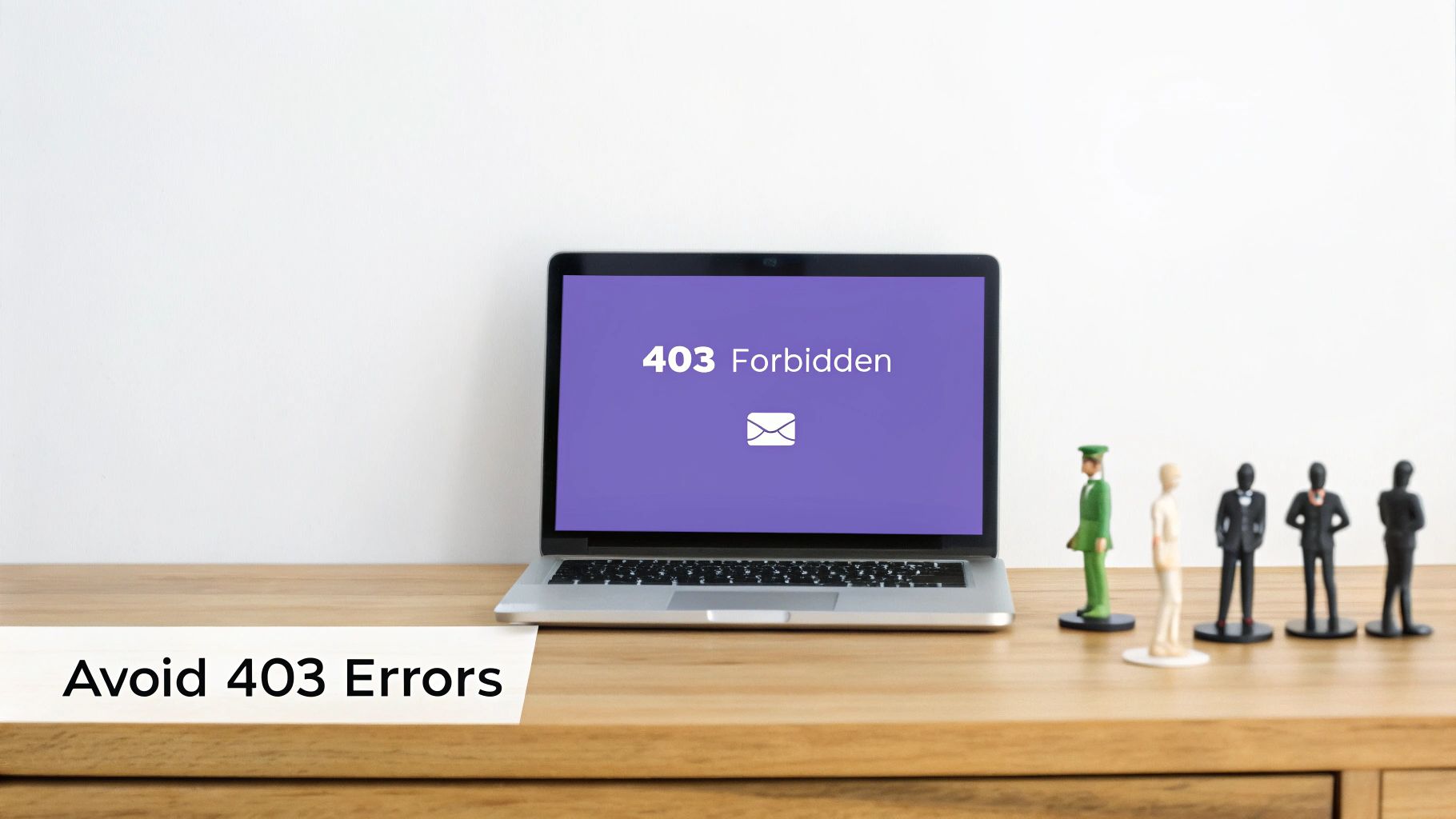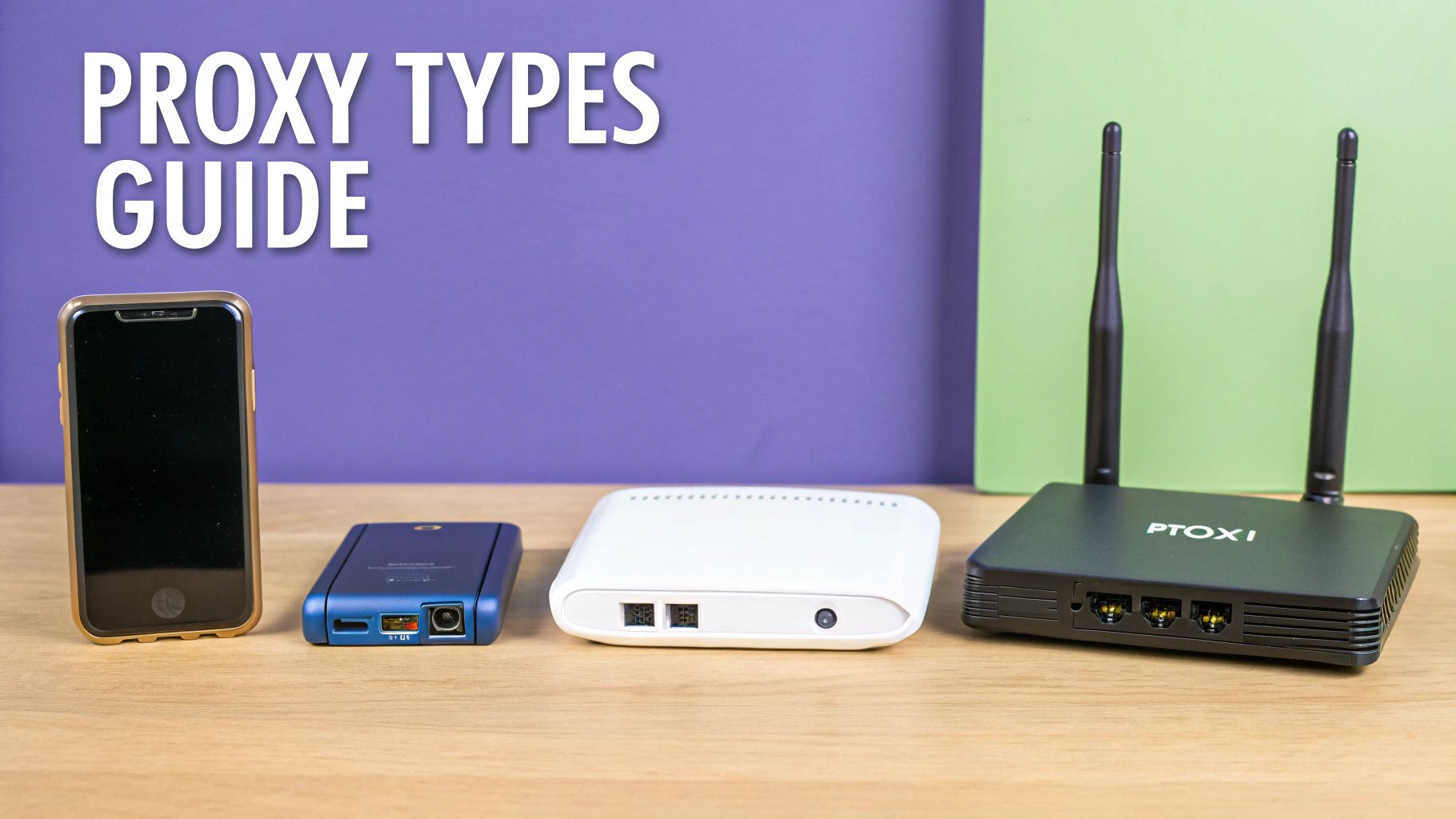If you’ve ever tried scraping a website, you’ve probably run into the dreaded ‘403 Forbidden’ error. It’s a frustrating roadblock, but there’s a straightforward solution: proxies for scraping. These tools are the secret sauce for successful data collection, acting as a middleman to hide your real IP address and keep your projects from getting shut down.
Why Proxies Are a Necessity for Web Scraping
Think of it this way: trying to scrape a website from a single IP address is like trying to knock on a thousand doors in the same neighborhood all at once. It’s unnatural, suspicious, and you’re going to get noticed. Sending thousands of requests from one IP is a dead giveaway to a web server that you’re a bot, not a regular visitor. This is exactly where proxies become non-negotiable.

A proxy server hands you a different IP address for your requests, making it look like your traffic is coming from all over the place. Instead of one person knocking on every door, it’s now a whole team, each visiting a different house. This distributed activity blends right in with genuine, organic traffic from multiple users, keeping your scraper under the radar.
Overcoming Common Scraping Roadblocks
Proxies are designed to solve the most frequent headaches that bring data extraction projects to a grinding halt. Websites have become incredibly smart, using effective strategies for securing web applications to fend off bots. Proxies are your key to navigating these defenses.
Here’s what they help you beat with practical examples:
- IP Bans and Blocks: The oldest trick in the book. A website sees too many requests from one IP and just blocks it. Actionable Insight: Use a rotating proxy pool. If your scraper tries to pull 1,000 product pages and IP
1.2.3.4gets blocked after 100 requests, your script should automatically switch to5.6.7.8for the 101st request and continue seamlessly. - Rate Limiting: Many sites cap the number of requests an IP can make in a given period (e.g., 60 requests per minute). Actionable Insight: By spreading your 6,000 requests per hour across a pool of 100 proxies, each IP only makes one request per minute, staying well below the limit and avoiding timeouts.
- Accessing Geo-Restricted Content: Need to see what a product costs in Japan or what news is trending in Brazil? Actionable Insight: To scrape flight prices from London to New York, use a proxy with a UK-based IP. To check the same flight from the perspective of a user in the US, switch to a US-based proxy. This reveals regional price differences. Our detailed guide on data scraping dives deeper into how this works.
The game has changed. Modern websites don’t just look at your IP anymore; they analyze your entire digital footprint to figure out if you’re a bot.
Fast forward to 2025, and proxies are no longer just an add-on—they’re a core part of any automated workflow. Demand for residential and mobile proxies has exploded, more than tripling since 2023. Why? Because they’re much harder to detect and are fantastic at mimicking real users.
Websites now use sophisticated behavioral analytics, tracking everything from your screen resolution and browser plugins to how fast you type. A simple IP swap isn’t enough. Proxies have become a fundamental, must-have component for any serious data gathering operation.
Choosing the Right Type of Scraping Proxy
Not all proxies are created equal. Picking the wrong one is like bringing a rowboat to a naval battle—you’re just not going to get very far. The type of proxy you use directly impacts your success rate, your budget, and your ability to fly under the radar.
Getting a handle on the core differences between the main options is the first step toward building a scraping operation that actually works.

Each proxy type brings a unique balance of speed, cost, and stealth to the table. Let’s break down the four primary categories you’ll run into when you’re looking for proxies for scraping.
Datacenter Proxies: The Speedsters
Think of datacenter proxies as using a well-known commercial office address. They aren’t tied to an Internet Service Provider (ISP) but come straight from powerful servers in, you guessed it, data centers. This setup makes them incredibly fast and affordable.
Actionable Insight: Use them for scraping targets with simple bot detection, like a public directory or a basic forum. For example, if you need to quickly gather a list of company names from a B2B portal that doesn’t use Cloudflare or Akamai, datacenter proxies are a cost-effective choice.
Residential Proxies: The Chameleons
For most serious scraping projects, residential proxies are the gold standard. These are real IP addresses assigned by ISPs to actual homeowners, making your scraper’s traffic look exactly like a regular person browsing from their couch.
Actionable Insight: This is your go-to for scraping e-commerce giants like Amazon or sneaker sites like Nike. These platforms have advanced anti-bot systems that easily flag datacenter IPs. A residential proxy makes your requests appear as legitimate customer traffic, dramatically increasing your success rate. When you absolutely need to appear authentic, a quality residential proxy is your best bet.
The proxy market has heavily shifted toward authenticity. By 2025, residential proxies command over 70% of the enterprise web scraping market, showcasing their dominance for high-stakes data collection.
This trend says it all: modern scraping is about blending in, not just being fast. As of 2025, residential proxies deliver success rates between 85-95% on complex targets. That’s a massive leap from the 40-60% you’d be lucky to get with datacenter proxies. This performance justifies their higher cost, which typically ranges from $8 to $15 per gigabyte.
ISP Proxies: The Hybrid Powerhouses
ISP proxies, often called static residential proxies, give you the best of both worlds. They are hosted on data center servers—giving them speed and stability—but are officially registered with ISPs, which gives them the legitimacy of a residential IP.
Actionable Insight: Use an ISP proxy when you need a stable, trustworthy IP for an extended period. For example, when managing multiple social media accounts, you need a consistent IP that won’t change mid-session, as this could trigger security alerts. ISP proxies provide that stability without the higher detection risk of datacenter IPs.
Mobile Proxies: The Elite Operators
When you’re up against the toughest targets, mobile proxies are the ultimate tool. These proxies route your traffic through real mobile devices connected to cellular networks like 4G or 5G.
Actionable Insight: Mobile proxies are essential for scraping mobile-first platforms like Instagram or TikTok, whose apps and websites are optimized to detect non-mobile traffic. Since many real users share the same mobile IP, websites are very reluctant to block them, giving you an almost guaranteed high success rate.
Proxy Type Comparison for Web Scraping
To make the choice a bit easier, here’s a quick rundown of how these four proxy types stack up against each other for web scraping.
| Proxy Type | Primary Use Case | Success Rate | Cost | Detection Risk |
|---|---|---|---|---|
| Datacenter | High-speed scraping on low-security sites | Low (40-60%) | Low | Very High |
| Residential | Complex targets requiring high authenticity | High (85-95%) | Medium | Very Low |
| ISP | Stable sessions, account management | High | Medium-High | Low |
| Mobile | Scraping mobile-first apps and difficult sites | Very High (95%+) | High | Extremely Low |
Ultimately, the best proxy depends entirely on your project’s specific needs—your target’s security, your budget, and how important it is to stay undetected.
How to Select a Reliable Proxy Provider
The market for proxies for scraping is a jungle. It’s crowded, noisy, and full of providers making big promises. Picking the wrong one doesn’t just waste your money—it can tank your entire project with unreliable data and constant failures. To cut through the marketing fluff, you need a practical checklist that focuses on what actually matters for scraping success.
Think of a provider as a long-term partner, not just a vendor selling you a list of IPs. Their promises are only as solid as the infrastructure backing them up. So, instead of just looking at the price tag, you need to dig deeper into the quality and ethics of their service.
Evaluate the IP Pool and Sourcing
The absolute heart of any proxy service is its IP pool. And while size is important, the health and diversity of those IPs are what really count. A massive pool of flagged, blacklisted, or abused IPs is completely useless. You need clean, reliable addresses that fly under the radar.
When you’re vetting a potential provider, here are the non-negotiable questions to ask:
- How big and diverse is your IP pool? You’re looking for millions of IPs spread across tons of countries and cities. This is critical for any project that needs precise geo-targeting.
- How do you source your residential IPs? This is a deal-breaker. Reputable providers must be transparent about their consent-based sourcing. Real users should be knowingly and willingly sharing their connection. If a provider gets cagey about their sourcing methods, run.
- How do you monitor IP health? Good providers are constantly checking their IPs for flags and kicking out the poorly performing ones. This is how they maintain high success rates and keep your scrapers running smoothly.
A provider’s transparency about IP sourcing is a direct reflection of its reliability and ethical standards. If they can’t give you a straight answer on how they get their residential IPs, it’s a massive red flag.
Scrutinize Performance and Features
Beyond the IPs themselves, a provider’s technical features will either make or break your scraping projects. You need granular control to adapt to different websites and tricky scraping scenarios.
Actionable Insight: Look for essential features like rock-solid session control. For scraping search results, you need rotating IPs (a new address for every request). For navigating a checkout process, you need sticky sessions (keeping the same IP for 5-10 minutes). A good provider lets you switch between these modes easily, often with a simple change to your proxy username (USERNAME-session-sticky vs USERNAME-session-rotating).
The market is clearly shifting toward authenticity and performance. Research from 2025 shows that residential proxies are the most popular and fastest-growing proxy type on the planet. Why? Because they are far harder for websites to detect and block compared to datacenter proxies, which are quickly losing their effectiveness for tough scraping jobs. You can find more insights about the proxy market on proxyway.com.
Integrating Proxies Into Your Scraping Code
Alright, we’ve covered the what and the why of scraping proxies. Now for the fun part: actually putting them to work in your code.
Good news—integrating a proxy is usually a lot less painful than you might think. Most modern scraping libraries and frameworks are built with proxy support baked right in. Often, it just takes a few extra lines of code to start routing your traffic.
This section is all about practical, copy-paste-ready examples to get you going. We’ll walk through the most common tools so you can stop staring at connection errors and start collecting the data you need.

Python Requests Proxy Setup
The requests library is a fan favorite for web scraping in Python, mainly because it’s so straightforward. To get it to use a proxy, all you have to do is define a dictionary with your proxy’s details and pass it along with your request. Simple as that.
Here’s a quick snippet that shows how to route both HTTP and HTTPS traffic. This is perfect for a quick test to make sure a single proxy IP is working correctly.
import requests
# Replace with your actual proxy credentials and address
proxy_url = "http://USERNAME:PASSWORD@proxy.ipfly.net:8080"
proxies = {
"http": proxy_url,
"https": proxy_url,
}
try:
# This request will be sent through the specified proxy
response = requests.get("https://api.ipify.org?format=json", proxies=proxies, timeout=10)
print(f"Success! Response from proxy IP: {response.json()['ip']}")
except requests.exceptions.RequestException as e:
print(f"Proxy request failed: {e}")
In this example, the proxies dictionary is what tells requests where to send the traffic. Don’t overlook timeout=10—it’s a critical little addition that stops your script from hanging forever if a proxy server decides not to respond. For a more detailed walkthrough, our guide on seamless proxy integration covers more advanced setups.
Browser Automation with Playwright
When you’re scraping dynamic, JavaScript-heavy websites, you’re probably reaching for a browser automation tool like Playwright or Selenium. These tools drive a real browser, and thankfully, getting them to use a proxy is just as easy.
With Playwright, you can specify your proxy settings right when you launch the browser instance. This approach ensures that every single action the browser takes—from loading the initial page to fetching resources with JavaScript—gets routed through your proxy.
One thing to remember: when using browser automation, every single resource request (images, CSS, scripts, fonts) goes through the proxy. This can chew through bandwidth much faster than a simple library like
requests.
Here’s how you’d typically configure a proxy in a Playwright script:
from playwright.sync_api import sync_playwright
# 1. Define Server Settings
proxy_server = {
"server": "http://proxy.ipfly.net:8080",
"username": "YOUR_USERNAME",
"password": "YOUR_PASSWORD"
}
with sync_playwright() as p:
# 2. Launch Browser with Proxy
browser = p.chromium.launch(
headless=False,
proxy=proxy_server
)
page = browser.new_page()
# 3. Perform Actions
page.goto("https://www.ipchicken.com/") # This will show your proxy's IP
page.wait_for_timeout(5000)
browser.close()
This method is key for consistency. It makes your entire browsing session look like it’s coming from the proxy’s IP address, which is essential for avoiding detection on smarter target sites. Getting this right is a huge step toward building a scraping workflow that’s both robust and reliable.
Effective Proxy Management and Rotation Strategies
Just having a pool of proxies for scraping isn’t the finish line—it’s the starting block. What really separates a successful data pipeline from a pile of blocked IPs is how you manage them. A smart strategy is about more than just switching addresses; it’s about convincingly mimicking human behavior.
This means your scraper has to send realistic browser headers with every single request. Think about it: if your proxy IP is from Germany, but your browser headers scream “English (US),” that mismatch is an easy red flag for any anti-bot system. The goal is to make each request look like it came from a unique, genuine user.

Along the same lines, you have to watch your speed. Firing off hundreds of requests per second from one IP is a guaranteed way to get the boot. Throttling, which just means deliberately slowing down your requests to a more natural pace, is absolutely critical for staying under the radar.
Implementing Smart Rotation and Retries
Intelligent IP rotation isn’t just about picking a new proxy at random. A truly robust system will automatically detect a failed request, ditch the problematic IP, and immediately try again with a fresh one from your pool. This automated retry logic is the backbone of any scraper that’s built to last.
Here’s a look at a practical rotation workflow:
- Select a Proxy: Grab an available IP from your pool for the next request.
- Make the Request: Send it out with matching user agents and headers to look legit.
- Check the Response: If you get a success code (like 200 OK), great! Log the data and move on.
- Handle Failure: If you get an error (like a 403 Forbidden or 429 Too Many Requests), that IP is probably toast. Your script should automatically toss it and go back to step one with a new proxy.
Actionable Insight: Implement a counter for each proxy. If a proxy fails more than 3 times consecutively, remove it from your active pool for an hour. This “cooldown” period prevents you from wasting time on a temporarily blocked or offline proxy.
The most sophisticated scraping operations don’t just rotate IPs; they rotate entire digital fingerprints. This includes changing user agents, screen resolutions, and browser versions in sync with the new proxy to create a completely new, believable user profile for every few requests.
The Proxy Waterfall Technique for Cost Efficiency
Managing proxies is also about managing your budget. One of the most effective and wallet-friendly strategies out there is the proxy waterfall technique. It’s a tiered approach that prioritizes cheaper proxies first, only escalating to the pricey ones when you absolutely have to.
This is how it works in practice:
- Step 1: Start by attempting the request with a cheap datacenter proxy.
- Step 2: If that fails (e.g., you get a CAPTCHA or a block), retry the same request with a more reliable (and more expensive) ISP proxy.
- Step 3: If you’re still out of luck, escalate one last time to a premium residential or mobile proxy, which has the best shot at success.
This method makes sure you only pay for premium proxies on the toughest requests. It dramatically cuts your overall costs while keeping your success rate high—a tactical approach that protects both your scraper’s performance and your bottom line.
Common Questions About Scraping Proxies
Even with the best strategy in place, you’re bound to run into questions when you start working with proxies for scraping. This final section cuts through the noise and tackles some of the most common practical concerns. Think of it as your go-to reference for clear, straightforward answers to help you troubleshoot on the fly.
What Is the Difference Between Rotating and Sticky Proxies?
This is easily one of the most frequent questions we get, and the answer really boils down to what your scraping project needs to accomplish.
-
Rotating proxies are all about volume and anonymity. They assign a brand-new IP address to every single request you send out. Practical Example: Use rotating proxies when scraping Google search results for 10,000 different keywords. Each search is independent, so changing the IP every time prevents Google from detecting a pattern and blocking you.
-
Sticky proxies, sometimes called session proxies, do the opposite. They let you keep the same IP address for a specific amount of time—often for 5, 10, or even 30 minutes. Practical Example: Use a sticky proxy to navigate a multi-page checkout process on an e-commerce site. Your IP must remain the same from the “Add to Cart” step all the way through to the “Confirm Purchase” page to maintain a valid user session.
Here’s a simple way to remember it: rotating proxies are for mass browsing where you need to look like a crowd. Sticky proxies are for tasks where you need to look like one consistent person.
Can I Use Free Proxies for My Scraping Project?
While the idea of a “free” solution is always tempting, using free proxies for any serious scraping project is a recipe for disaster. It’s just not worth it. They are notoriously slow, incredibly unreliable, and almost always already blacklisted by major websites, which means you’ll be dealing with constant failures.
But the biggest problem with free proxies isn’t even their terrible performance—it’s the massive security risk. The people running these free services can easily watch, intercept, or even change the data you send and receive. That includes sensitive stuff like login credentials.
Actionable Insight: Instead of free proxies, look for paid providers that offer a free trial or a small, cheap starter package. This allows you to test their performance and reliability on your specific target without the security risks associated with free public proxies.
How Many Proxies Do I Need for My Scraping Task?
There’s no magic number here. The right amount of proxies depends entirely on how sensitive your target website is and how many requests you plan on making. The best way to figure it out is to start small and pay attention to your results.
Actionable Insight: Start with a pool of 10-20 proxies and aim for a request rate of one request every 5-10 seconds per proxy. Monitor your success rate. If your error rate climbs above 5%, it’s time to either slow down your request rate or add more proxies to your pool to distribute the load more effectively.
For a low-security site where you’re only making a few hundred requests, a small handful of datacenter proxies might be all you need. But if you’re going up against protected giants like e-commerce marketplaces or social media platforms, you’ll need a pool of thousands of rotating residential IPs to fly under the radar and maintain a high success rate.
Ready to start scraping without getting blocked? IPFLY offers a robust network of over 90 million ethically sourced residential, ISP, and datacenter proxies to power your data collection projects. Get reliable, high-speed access and stop worrying about IP bans. Explore IPFLY’s proxy solutions today!


